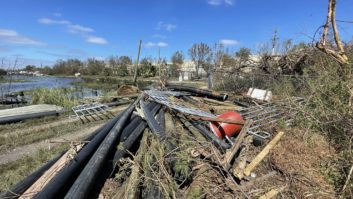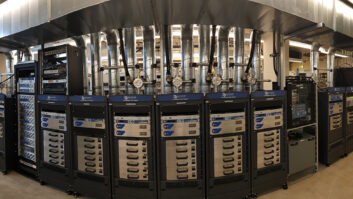I�ve written quite a bit in the digital pages of DRU about how the one-to-one nature of unicast transmission over IP and cellular networks is incredibly inefficient and for that reason, will likely not supersede over-the-air broadcast transmission. I�ve finally been �brought up to speed� regarding a technology that, frankly, scares me.� It�s not really news (the article I�m referencing below is from last year), but it�s likely something most broadcasters haven�t been made aware of�at least, not yet.
The article is frombroadcastbridge.comand I�m going to include the germane paragraphs below. The underlines are mine.�
�LTE Broadcast is based on the eMBMS (Evolved Multimedia Broadcast Multicast Service)point-to-multipointinterface specification developed for delivery of any content received by multiple viewers at the same time, including files and emergency alerts as well as broadcast video. The motive in all cases wasto avoid consuming large amounts of bandwidth through transmission of the same data over multiple unicast sessions, which is particularly expensive in the case of HD video.�
The article is specifically talking about television and how the cellular companies want to be able to deliver this easily to as many customers as they can.� But, there�s more to it.� Here�s the scariest part: �…while a lot of the initial interest in LTE Broadcast has been for multicasting to single cells for live events,the technology is also a contender for large scale TV and radio transmission, given that it supports single frequency network (SFN) operation.�
Not surprisingly, those of us that would find our oxes gored by this new technology are somewhat alarmed.� That group includes the European Broadcasting Union.
�…the EBU has conducted head to head comparisons between LTE Broadcast and the second generation digital terrestrial technology DVB-T2, results of which were announced early 2014.
�…the EBU produced two separate but related reports, one on spectral efficiency and the other on costs (both Opex and Capex). The analysis homed in on the main reception scenarios, fixed outdoor aerial, in-car, portable outdoor, near indoor reception (e.g. in a room with outdoor window), and deep indoor reception. The other variable was the ISD (Inter Site Distance), the gap between neighboring base stations, which ranged from 1 km to 10 km in the analysis.
�The main conclusion from this first study was that LTE Broadcast would only be capable of delivering robust linear services when deployed in the sort of dense networks confined largely to urban areas. A similarly negative verdict was delivered for cost. �The EBU research found that for very dense configurations LTE Broadcast would cost 25 to 30 times more to deploy than existing broadcast networks, although this comes down to 7 to 8 times for less dense configurations that would still deliver adequate spectral efficiency. The cost ratio comes down further if deep indoor coverage is required, where LTE Broadcast scores more highly.�
Clearly, in urban areas, LTE Broadcast makes some kind of sense.�
�It is also worth considering the potential for revenue generation through location-based advertising and information services, not just at sporting events or concerts, but also venues where people congregate continually in large numbers, such as airports, shopping malls and college campuses. This could prove a lucrative market for LTE Broadcast as well, since it involves simultaneous multicast transmission of the same content.�
It seems that the cellular companies have now figured out the broadcasting business. When you consider that they deliver signals to the kinds of devices that people actually want to use, in ever-increasing numbers, then it remains worrisome, indeed.�












